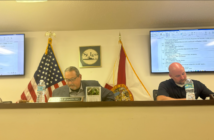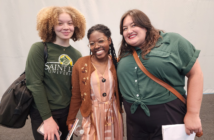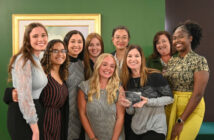The Department of Mathematics and Science, since 2013, have been having their normal weekly Math Circle Outreach program held Thursdays at Saint Leo University Campus in Lewis Hall, Room 207. This program was established by Monika Kiss, associate professor of mathematics.
The weekly program usually takes place from 6pm to 7pm. One of the students who helps lead the sessions spoke on the preconceived notions surrounding mathematics.
“Sometimes there is this stigma that mathematics is hard, and as mathematics majors we love mathematics, and Dr. Monika Kiss, the professor of mathematics, loves maths more than anyone. The purpose of this program is to promote the subject of maths and have students admire and to appreciate mathematics,” said Rachel Cunio, a junior mathematics major.
“It my way of reaching out to middle school students, encouraging them to like mathematics, it is free program. It is a national organization that we are part of, it is a large organization, so you can Google National Math Circles and we are listed under Math circles, it is one of the four Math circles in the state of Florida. What we do is […] hands on activities to encouraged girls and boys to like Maths. We just want to spread the world with math fun and is not just work sheets they get to do […] to study for exam,” said Kiss.
Kiss went further by speaking on how successful the program has been.
“The unfortunate fact is that most of students that are motivated to do something like this are also involved in so many other after school activities, so it is hard for them to get to campus. I think we are not advertising it enough, I don’t think we have enough people know about us, but it is also the fact that we meet Thursday nights, people are tired, [and]kids have athletic things going on,” said Kiss.
“Some people suggest that if I charge money people will come, but I don’t want to do that, I want to do these for free, I want to help our community. We don’t have enough opportunity like this for kids in the neighbourhood of Saint Leo University,” Dr. Kiss added.
Cunio, said that that this program is done every week on Thursday night; it is about an hour long.
“We start [in]the fall as soon as we start school and we end before summer. And I am actually doing my apprenticeship under Dr. Kiss and starting this program is part of the apprenticeship,” said Cunio.
In acknowledgment Kiss said, “I usually just come up with an idea, sometime Thursday morning. In Jan. and Feb. we did graph theory. So every Thursday we did a different part of graph
theory, in the fall we did a lot of geometry. We did a lot of preparing for the E.M.C Exam, which is the national mathematics test for middle and high school students, so it is a sort of random ideas that I think kids will enjoy.”
Kiss also said that she created a website for the math major, saintleomathematics.com. There will see some of the pictures from the past activities; people can see also see what kind of things the program has done before.
“We have pictures of the past kids and we have permissions for us to use their picture. And it’s just topics that I put on there, titles for the day events. [The program] is open to anybody who wants to come, it is completely free, and we just want to encourage mathematics fun,” said Kiss.
In order to show a high level of achievement of math circle on Saint Leo, Cunio, on Mar. 24 became the instructor of the day and taught M&M’s Mathematics.
“It means making predictions, calculating percentages, and comparing our individual percentage to what M&M’s […] have in a bag,” Cunio said.
On this Kiss said, “It [is]probability and that is much deeper than just the ratio. They were addressing what percentages of blue M&M’s in an average bag of M&M’s [there are]. It’s fun for the kids because it is hands on math.”
“Probability is credibly important, statistics is very important. People want to know what we do. What we do in maths circle is, we do seriously high level of math at a level that the students can understand. We do high level of geometry, we do sequences, we do series, we do mathematics they don’t see in middle school, and we do it in way they can relate to. Graph theory is something that some maths major never see or see very little of, but we do it in a level the kids can understand,” said Kiss.
Kiss pointed out that the program is to intrigue some students to see that maths is not just algebra, is not just computation, is not just hovering, it is a beautiful subject. Maths is everywhere, which is what math circle is all about: problem solving, critical thinking, working in teams, talking to each other, being in a place where people are accepted for liking math.
Cunio started her instruction by opening a bag of chocolate containing a total of 48 M&M’s and differentiated it by colours; 9 blue, 7 brown, 6 green, 11 orange, 6 red, and 15 yellow. Then she placed the numbers according to their colours in a sorting sheet. She calculated it according to the percentages of the colours and analyzed all the individual pack’s data to verify M&M’s claim. Later she put the percentages in a graph form and compared it with what the M&M’s Mars, Inc have on their website.
“[It] is not just that we are learning [mathematics]but we are applying it to a [real life situation to]double check the [company’s claim] to make sure they are in line with us, thereby using it to improve our knowledge of mathematics,” said Mel Shevy, a junior biology major.
In acknowledgment, “This M&M’s Mathematics has given me the opportunity to develop my knowledge of calculation and teach another form of calculation, which I have not learned in my mathematics class,” said Anna Gorman, seventh grade student of Paschal Middle School.
Conclusively, Kiss encourages anyone who is interested in sharing something they think is math related to come out and be a part of the program. So if there is a student or faculty that wants to do a presentation, they are always invited to participate. It is a great way to give back.
“The beauty is, in my humble opinion, math is everywhere. Even in theology, you can probably find maths. Theology and Philosophy kind of all sort of goes back to some similar ideas, like logic. That’s the only requirement, that there has to be some kind of mathematical flavour to the presentation,” said Kiss.




